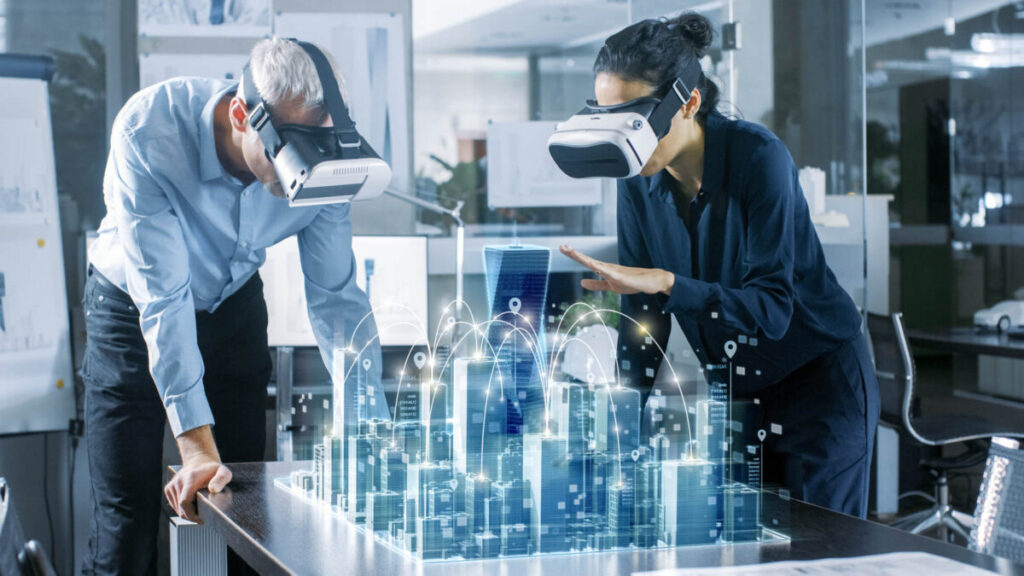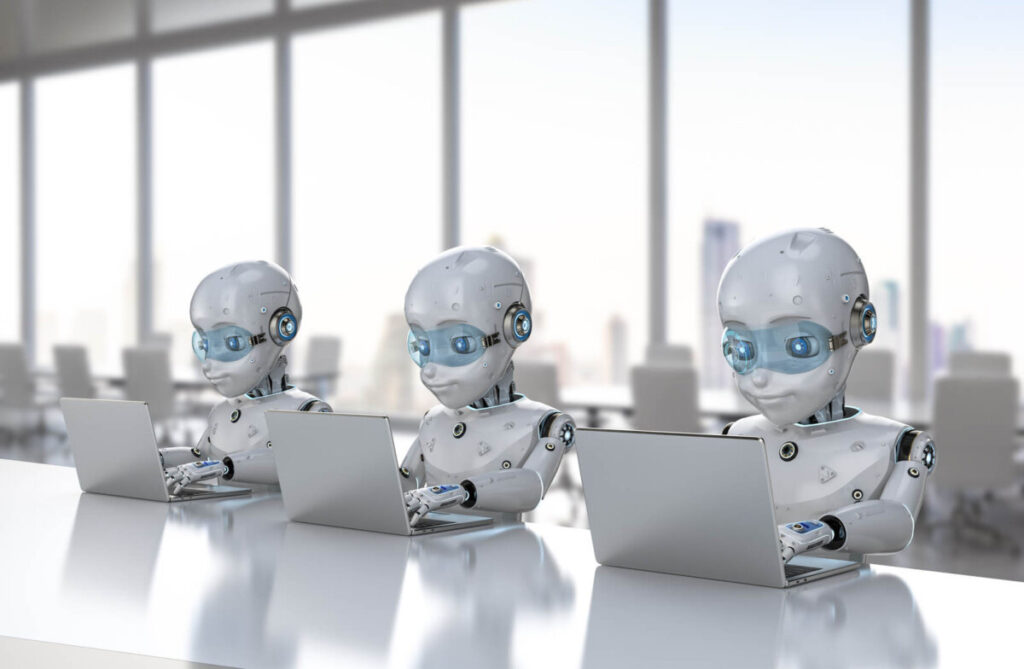
How the world of work will look in 2030
What will work look like in 2030? It could be a shorter, flexible week, where we work wherever we want. A nirvana of AI aides, hologram meetings and modern managers who have learned not to micromanage.
Or we could be always-on, expected to instantly reply to queries from colleagues scattered across time zones. Colleagues who we’ve only ever spoken to in digital form, interacting in virtual metaverses regardless of whether we’re sat in the office or our own homes.
What we know for sure is that pandemic lockdowns were the catalyst for long-coming change in office work. Video calls, remote work and digital collaboration all became normalised. While some companies have pushed to get employees back into office, the Monday to Friday drudge is a thing of the past.
In our post-Covid world, technology, office design and management practises are rapidly evolving to catch up. But this is just the start. Expect further impacts from work-altering technologies such as generative AI, VR headsets and more. Seven years may not sound long, but think how much has changed in two years. The workplace of 2030 will look very different from today.
What will offices look like?
Forget rows of desks, and so long to offices. Offices in 2030 will be all about in-person hot desks and hybrid meeting rooms to make hybrid work more efficient. Alongside benefits such as free gyms and subsidised cafeterias to draw in remote workers.
Companies might pair up with partners or related firms to share office space as more of us work from home. This brings a chance for collaboration, for serendipitous chats, but also our first security challenge.
Another weak point for security teams will be the continued use of personal devices at work. “People expect to use their own device, which is complicated,” futurist Liselotte Lyngsø told TechFinitive.
But if the purpose of going into the office is to work with colleagues, we’ll need more meeting rooms and breakout spaces. We’ll also need quiet zones to plonk down a laptop and get a few emails done without interruption.
Whether managers cling to their private offices or not, companies need to solve hot desking. Expect a growth in desk-booking software – and workplace surveillance for micromanagers who haven’t adapted to the new way of working and measuring productivity.
“Looking ahead, performance and productivity will look different for different teams, and companies will need to adjust their performance measurement metrics to move away from using time as the sole indicator and focus more on measuring impact,” said Liz Leigh Bowler, Modern Work Product Lead for Microsoft UK.
Virtual meetings
We need to fix hybrid working meetings. It’s still way too awkward when some colleagues dial in and others are in the room. Solutions range from telepresence robots to the metaverse or even holograms. “With advancements in video meeting platforms, meetings will become more of an immersive experience – merging the virtual with the physical as we enter the next phase of digitisation,” said Bernard Marr, futurist and author of Future Skills: The 20 Skills and Competencies Everyone Needs to Succeed in a Digital World.
Holograms or VR headsets could bring off-site staff into the room, while virtual meetings with avatars might reduce Zoom exhaustion. “Given current rates of investment, virtual meetings software is likely to have seen major improvements,” said futurist William Higham. “Indeed, although the metaverse may not catch on everywhere, it offers a model for future workplace interactions. I look forward to creating a stylish workplace avatar.”
To hold our attention, meetings will go 3D, predicts Prezi CEO Jim Szafranski. “At Prezi, we’ve started to lay the groundwork for 3D meetings, bringing in cinematic elements, layers of visual content and movement to the meeting screen,” he said. “We’ve found that introducing elements of 3D increases employee attention during meetings and reduces the tendency to wander to a second screen or multitask.”
And that means the rise of VR headsets, Szafranski believes, with such devices becoming standard corporate technology. “In a deeply embedded virtual workplace, attentional content will remain a top priority,” he said. “We’ll see the entire workflow move on-screen and heads-up style content will be the new norm to keep everyone focused in one place.”

Asynchronous working
Perhaps you don’t need to go to meetings at all. If you’re just there to listen, why not do it in your own time? Hybrid working doesn’t just need to apply to where you work, but when. And asynchronous working means you may be temporally out of step with your colleagues, making meeting as a group challenging.
Nor will you have to wade through the whole thing. Video analysis and AI transcription will pare down meetings to the sections you need. Imagine a personalised highlights reel of what applies to you. Or a text transcription can be automatically generated to read on your commute home – with added business intelligence benefits.
“In the future, all of our meetings will automatically be transcribed, forming large datasets that will be extremely useful to business development,” said Andy Wilson, director of new production solutions at Dropbox. “Imagine the value if you were able to access a repository that documented all of the decisions that a company had made over the past 30 years. The ability to mine the rationale behind each of them, across all of the different macroeconomic environments, would be immense.”
AI colleagues
AI cobots could help mine that information, which is just one example of how AI will change work beyond replacing jobs. While AI will automate some work, most of it will be tasks we humans aren’t good at, such as sifting through reams of data. Or perhaps the routine bits that eat up too much of our days as it is.
AI could mean we finally get answers from our data. The promise of AI tools such as ChatGPT is that they return natural language answers rather than links to pages with information, something Google has been trying to do in its search results. Apply that to big data in companies, and the change could be substantial.
“Want to revisit your workplace expenses policy? Smart cost management tools will analyse the cost of every company expensed meal in New York (with the appropriate exchange rates) and then dynamically adapt the company expense policy to better reflect a median cost by location,” predicted Wilson.
“Previous financial and sales forecasts will be modelled to automatically provide confidence scores and longer term predictions of revenue based on a wide range of measures. Gone will be the days of scrappy spreadsheet shuffling. Systems will analyse, weight, and provide probability-based assessments of performance, as well as of customer propensity.”

It’s likely that many of us will be using AI tools in some way or another. Perhaps in unexpected ways. “More and more of us will need to do jobs technology is currently less good at – ‘soft’ jobs that involve human interaction, empathy, personal sales, communication and so on,” said Higham.
“This will drive demand for technology that enables us to do that better. As so many studies now show, the best technology for this area will create a smart interface with machine-learning, augmenting human skills rather than replacing them. Initially that might be high-functioning tablets for sales staff. But increasingly interfaces will be more closely integrated: augmented reality glasses, contact lenses and in-ear headphones.”
Work schedules
Sorry Dolly Parton, the nine-to-five shift is over. After multiple successful proof of concepts and trials, many workplaces now offer flexible working, be it four-day weeks or flex time. By 2030 we’ll stop using the phrase hybrid working because it will be the norm. Employees will truly benefit from the flexibility and efficiency of technology to work less whenever it suits.
Don’t believe us? The trends are clear. “The workforce has already become more employee-centric as workers place a greater emphasis on when, where and how they work,” said Prezi’s Szafranski.
“We’ve seen how asynchronous work has made it easier for teams to have colleagues who work 20 hours per week or halfway around the world. This will also grow inclusion and allow companies to achieve greater scale by tapping into groups who might not be a fit for fully synchronous operations.”
There’s another side to this: why hire locally? Dropbox’s Andy Wilson argues we’re on the precipice of a truly global workforce, sparked by the shift to remote work. “As we shift to more intelligent business systems, and a greater reliance on asynchronous communications, we’ll see businesses look to attract the best calibre of talent wherever they are,” he predicted.
“In some industries, this shift has already begun, and it is not uncommon to see teams made up of people from across the world. In fact, my own team spans from across San Francisco to London, via Seattle, Arizona, Tennessee, New York and Dublin – hiring the best talent wherever they are.”
Lyngsø notes that this will be made easier by the rise of AI, as tools like ChatGPT get increasingly better at real-time translation, meaning companies can hire across language barriers. “That’s really going to shape the labour market,” she said.
Who’s in the office?
Companies will figure out that they can hire staff on flexible contracts, meaning people work for multiple bosses. “By 2030 many businesses will have put in place policies that enable them to grow and shrink their workforce where required,” said Higham. “To do this, they’re likely to reduce their permanent workforce and employ more ‘permanent freelancers’.”
And that means growth in the products and services to support such “permalancers”, he adds – think coworking spaces and management platforms. “Technology that enables freelancers to easily manage their time, client liaison and finances,” Higham explained. “Local spaces for them to work, which will need to combine a pleasant, communal environment with an excellent technological infrastructure – something too many new shared offices ignore.”
There’s plenty we can’t predict about 2030 – after all, few foresaw the pandemic’s epic impact on work – but there’s one thing we do know: we’re all going to be a few years older. And that’s important for generational shifts. By that year, enough boomers will have retired that Gen X will be in charge of the C-suite and Millennials will be snapping at their heels. Meanwhile, Gen Z will be fully entrenched in the workplace.
That generation shift will have yet more repercussions for the 2030 workplace, and beyond.
NEXT UP

James McQuiggan, Security Awareness Advocate at KnowBe4: “Ironically, attack methods have remained unchanged over the past twenty years”
In this interview, we hear from James McQuiggan, Security Awareness Advocate at KnowBe4 and a part-time Faculty Professor at Valencia College in Florida.

What is ocean-bound plastic and should you care?
Lee Grant digs behind the truth about ocean-bound plastics to explain why reducing them is a worthy cause – but that we need to treat marketing claims with due scepticism

Slow buyers cause tech firms to rethink sales approaches as tough Q1 hits home
New research suggests tech sales were slow in Q1, with buyers of technology and professional services taking their time before committing to any solutions.
